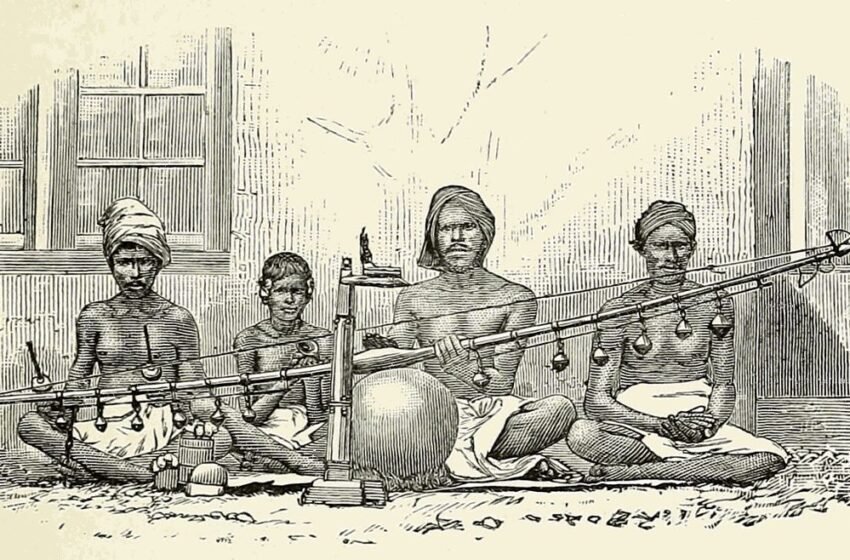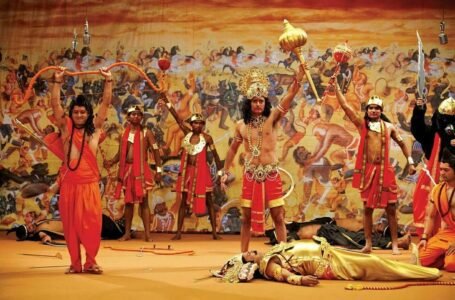Villupattu : The Vanishing Melodies of Tamil Nadu

Imagine a resonating bow, strung not for arrows but for stories—a captivating sound that sets the stage for tales of gods, heroes, and common folk. This art form, once echoing through the vibrant villages of Tamil Nadu, now fades into whispers. Can you guess what we’re talking about? Let’s unravel this musical mystery one clue at a time.
A String that Sings
It’s not a violin, nor is it a harp. This unique instrument resembles a hunting bow, strung tightly and played with a rhythmic tapping. Known as the “Villu”, or bow, this humble tool becomes a medium for performance. But it’s not just music; it’s storytelling elevated to an art form. Still guessing?
Songs That Tell Tales
These aren’t just melodies; they’re narratives. The performers weave epic stories from Indian mythology—Ramayana, Mahabharata, and tales of local deities—into their performances. Known as Villupattu, or “Bow Songs,” this ancient folk art combines music, drama, and oral storytelling, creating a cultural tapestry that both educates and entertains.
Villupattu: A Brief Introduction
Bow songs or Villupattu is a folk art form of Tamil nadu in which the performers sing, dance and tell stories using a bow shaped musical instrument. It involves one master performer who begins a story and a chorus who supplements it with drumming and shouting at appropriate junctures. The simplicity of the instrument contrasts with the depth of its purpose: to teach morality, history and culture in a rather entertaining manner.
That is why the Trailblazer is a Cultural Custodian—an Indigenous ecosystem of caregiving, supporting, learning, sharing and creating, imbued with love.
While its origins trace back centuries, one name stands out in its modern revival: Subbu Arumugam. Each maestro at his or her disposed devoted their life to the upkeep and performing Villupattu originality in a modern way. In many ways his innovations allowed the art practice to resist transformation and become modern while preserving tradition.
Origin and Etymology
Villupattu is referred to as ‘bow song’ in Tamil language ‘villu’ stands for bow and ‘pāttu’ stands for song, is a kind of folklore in Tamil Nadu, India. This novel form of art is coined ‘villu’ arts and crafts as the ‘villu’ is the main musical instrument of portraying such performances. The villu is tightened by strings that, when the strings are plucked, make music beats and at the same time acts as a prop in choreography.
It can be said that villupattu is females’ Folklore art form of village Tamil nadu which having rich cultural values. Hathi iti, leach believed it was created as aninative and unique way of educating the rural population on ethical, historical, mythological, and religious information. The performers of Villupattu are called Villupattu Pulavar meaning ‘bow song scholars’ referring to their educational aspect of the performance in addition to the performance art.
Historical Development
More precisely, Villupattu originated over 300 years ago. It came into the fore with the Nayak rule and after that continued to develop with the help of chieftains, as well as temple patrons. Originally sung and danced in temple compounds and especially in courtyards, Villupattu was in a way used to recount Ramayana and Mahabharata and legends stories of Murugan, Mariamman and Ayyappan.The Villupattu format also changed during the colonial era to suit the current social problems of that time. This was common in performers as they adopted patriotic theme, anti colonialism and social revolution. This latter use of satire as an art form was not just for cultural purposes, in that it helped to ensure that certain segments of the population were more aware, but also for strictly political purposes as well.
Mythological Significance
There is a particularly high relevance of mythology within the framework of Villupattu. The myths are dramatized, and tied together well with the use of singing, speaking, and laughter. For example:Murugan Worship: The Villupattu regularly describes stories of Lord Murugan, the hindu deity of war and wisdom with Tamil origin. Performances include the recounting of his fight with such demons as Soorapadman with much fear and telling of tales of bravery.
Ramayana and Mahabharata: This element is often used for child audiences as the stories featuring elements like the ‘ abduction of Sita’ , or the war of ‘Kurukshetra’ are enacted, making the difficult epics easier to be narrated.
Local Legends: Villupattu also has myths and legends of Tamilnadu like the Knagar Vilakkam – the story of Kannagi from silapathikaram or the bravery of Veerapandiya kattabomman.
Entertainment events that we get to witness have educative values; bring out the spirit us as a people as well as making us proud of our cultures.
Inheritance and Tradition
Villupattu occupies an, as it were, unResidents place within the cultural geography of Tamil Nadu. It carries on the oral narrative on folklore and history from one generation to the other. It has further developed into a communal art form that is enacted for temple carnivals, village meetings, and other places of assembly, and other celebrations.
Another principle tradition that permeates Villupattu’s history is flexibility. Today also it becomes an emotionally strongly charged medium as the songs being performed in Villupattu depict modern themes of the society like save environment, health, etc. The government and non-governmental organizations have used Villupattu to pass information concerning hygiene, polio eradication, and tolerance respectively.
Preservation Efforts
Nonetheless, their importance, Villupattu encounters issues in the contemporary world. Due to the availability of digital entertainment and shift in culturepeople prefer the product less now. However, various measures are being taken to preserve and revive this art form:
Government Initiatives: The Tamil Nadu’s Department of Art & Culture continues sensitization of Villupattu through workshops and festivals.
Documentation: There is an attempt being made in documenting and preserving Villupattu performances in their original forms.
Integration in Education: People of all age groups can learn it, and especially in schools and colleges, Villupattu must be included for cultural events.
Training Programs: Newcomers have discovered Villupattu and former artists are teaching young talents thus preserving the tradition and making it popular.
Variations Across Regions
Nonetheless, there are other forms of bow songs in other states though Villupattu is strongly connected with Tamil Nadu. Each version reflects the unique cultural and linguistic identity of its community:
Kerala: Its difference is that it is called “Villadichampattu” and it contains Malayalam lyrics and defs with performances about gods and local legends.
Karnataka: Residents of some areas of the Kannada region have modified Villupattu itself and included stories from Kannada literature and folk tales.
Sri Lanka: Specifically among Tamil of Sri Lanka, Villupattu is a combination of both Tamil and Singhala style and many a times depicts a harmonious multicultural coexistence of Sri Lanka.
It involves coordinating the structure and the performance style of an organization.
The performance of Villupattu usually a group of artists is coordinated by a main performer or the main narrator as referred to as the pulavar. Backing vocalists sing and musicians play along since the performers like to engage with their audience.
The Villu Instrument: The bow with bells on it the makes beats by striking against something. This sound belongs to vest basics of the musical performance.
Narrative Techniques: There are recited or sung stories, stories are told in prose and verse, and stories may be accompanied by humorous remarks and sermons.
Audience Interaction: This way, one of the main characteristics of Villupattu – audience interaction – is clear. Entertainers, therefore, ‘lead’ the activity to some extent and the process becomes socialised and engaging.
Thus, although it is not regarded as a mere art form but a cultural form of Tamil Nadu. This is probably one of the most remarkable strengths because it has evolved with the modern world but stays completely conservative. Through supporting Villupattu, we guarantee the known and diverse tradition of the unrevealed narrative will never vanish and will induce numerous generations.
Importance of Villupattu
In addition to being a form of entertainment, Villupattu is more of mass media communication. Historically, it was used to spread messages about:
- Religion and Spirituality: You can approach youth by teaching you stories about gods and their moral values.
- Social Awareness: It will also involve a process of enlightening people on matters to do with health, hygiene and order as well as understanding on matters of social cohesion.
- History and Heritage: As a means of transmitting the epics and other legends from one generation to the other.
Due to its unpretentiousness — a single bow and several participants creating a powerful storyline, it united different communities, even in distant villages.
The Art of Narration
The first one is based on the lead singer’s narration of an event in a song accompanied by the chorus who drum in beats at appropriate incidents. Of the two, the Villu is played as an idioaphonic instrument, though the sticks are used to play it with a unique tune. Intention, humor, wit, and audience interaction all enhance the performance making the performance multidimensional.
The tales are, in general, traditionally recited using a *call-and-response* format so that the audience participates. Unlike many other forms of folk art, villupattu isn’t merely singing and dancing, but it is the conversation between the singer and the listener.
Why Is It Rarely Heard Today?
Nonetheless, Villupattu is in the dying stage after having eulogized the glory of generations. Why?
- Urbanization: People from the villages and rural areas have shifted their lives to the cities, so those true art forms have lost their audience.
- Modern Entertainment: Whereas, folk performances have given way to television, movies and digital communication media as the form of entertainment.
- Lack of Support: Unlike other forms of art such as Villupattu is folk art therefore it lacks the support of institutions.
- Generational Gap: Andas a result, younger generations consider traditional art as obsolete which is a blow for traditional art forms.
A Bow for the Future
All hope is not lost. Efforts are being made to produce more of Villupattu to rejuvenate it and place it on a platform where people will get to know about it. Some effort to maintain this art is coming from cultural festivities, academic institutions and enthusiasts. Other factors are survivalist, for instance, by ensuring the issues portrayed are incorporated within the story are also there issues that play a role in making it believable to the modern society.
Conclusion: The Last Note
What most enthusiasts and lovers of Villupattu rarely realize is that Villupattu is not an art but it has something flowing in its veins which captures the spirit of Tamil Nadu. Like the tunes that are created and play to the listeners, those rhymes diminish when they stop and so does a portion of our history. Therefore, it may interest all the parties concerned to support its revival to see to it that future generations get to listen to the bow sing. Next time you hear the rhythmic beats of a Villu, remember: it’s not just music; it’s more of a narration of an untold story!
So, did you guess right? The next time you find yourself in Tamil Nadu make sure to lend your ears to the melodic beats of a Villupattu band.


